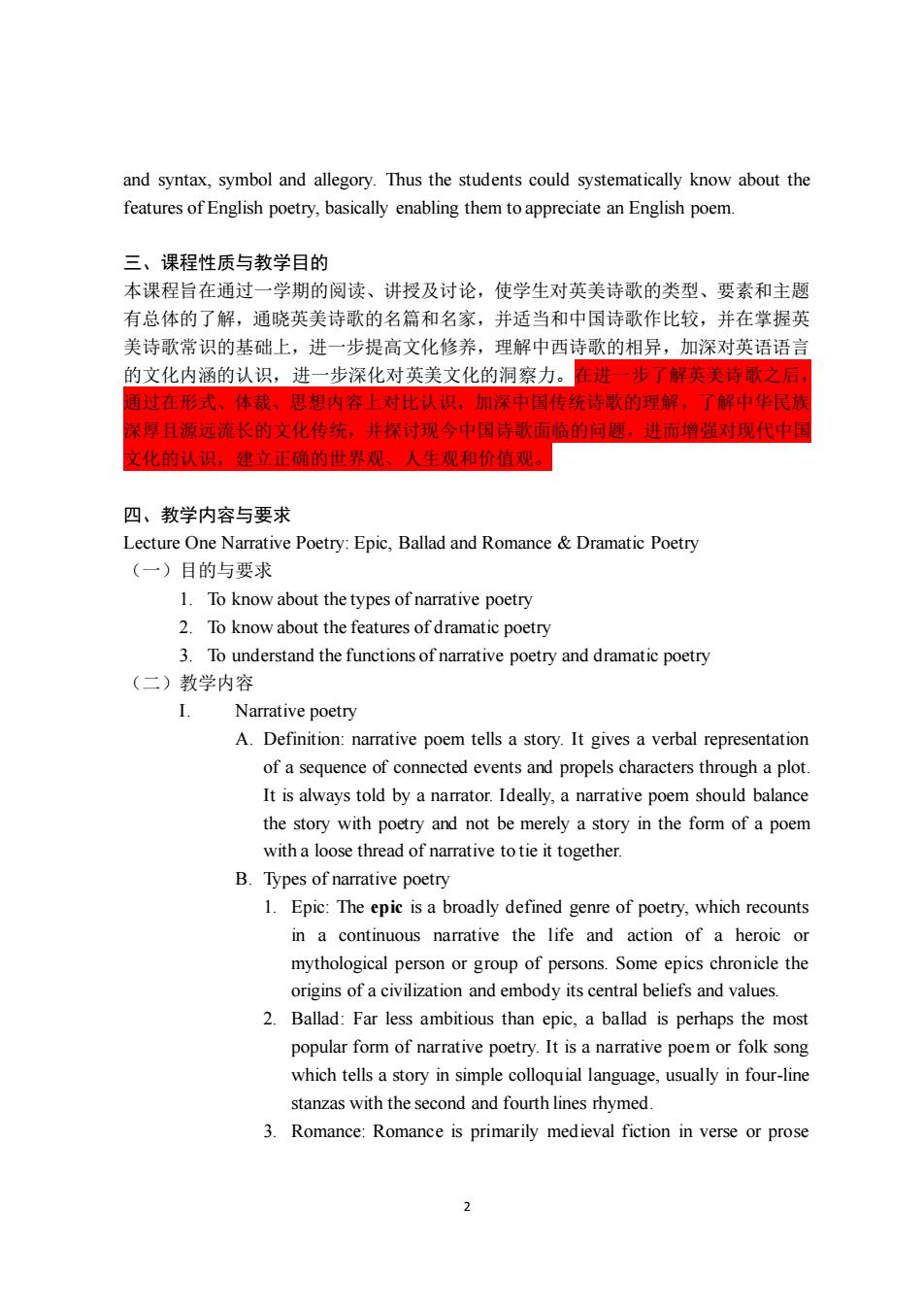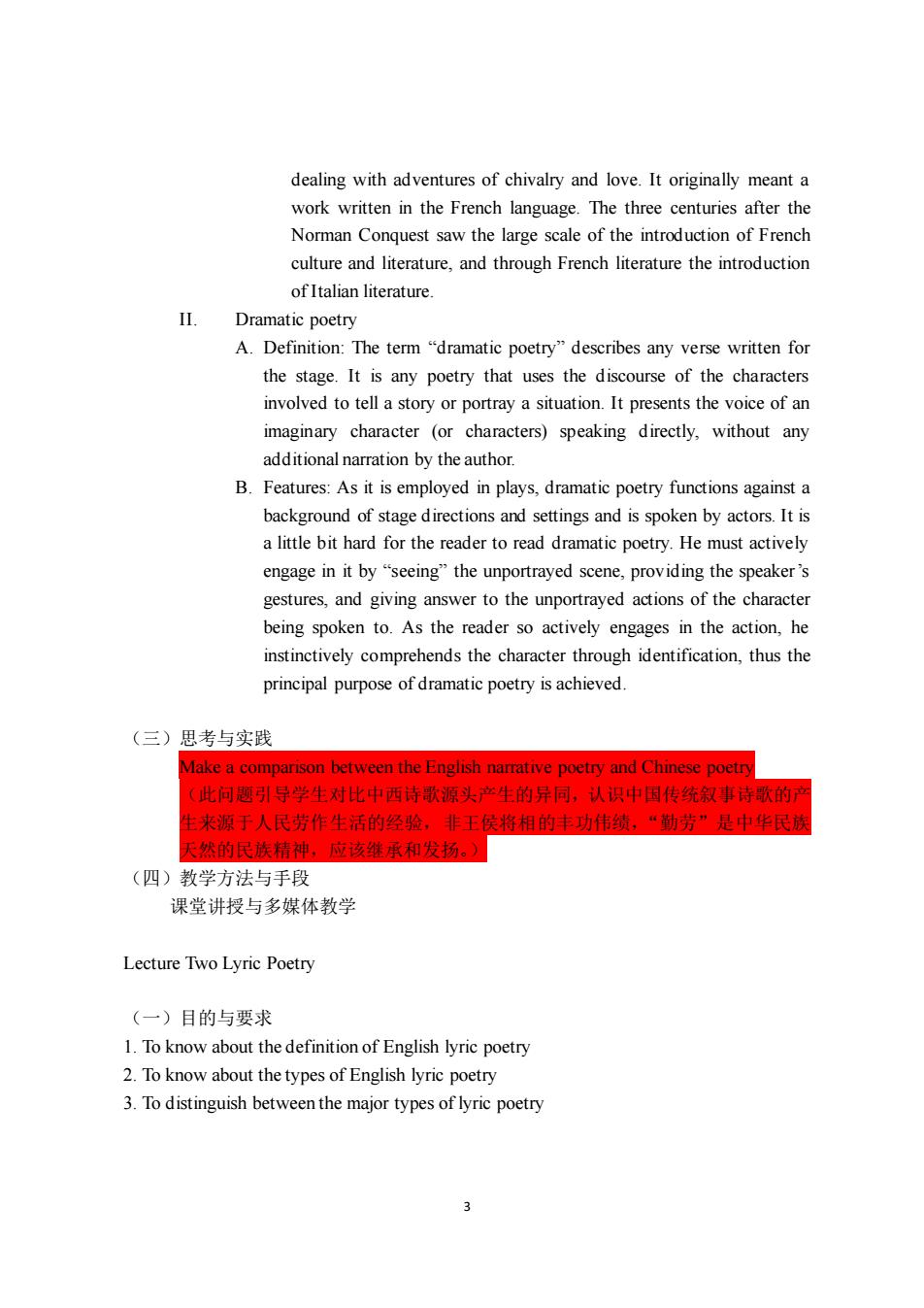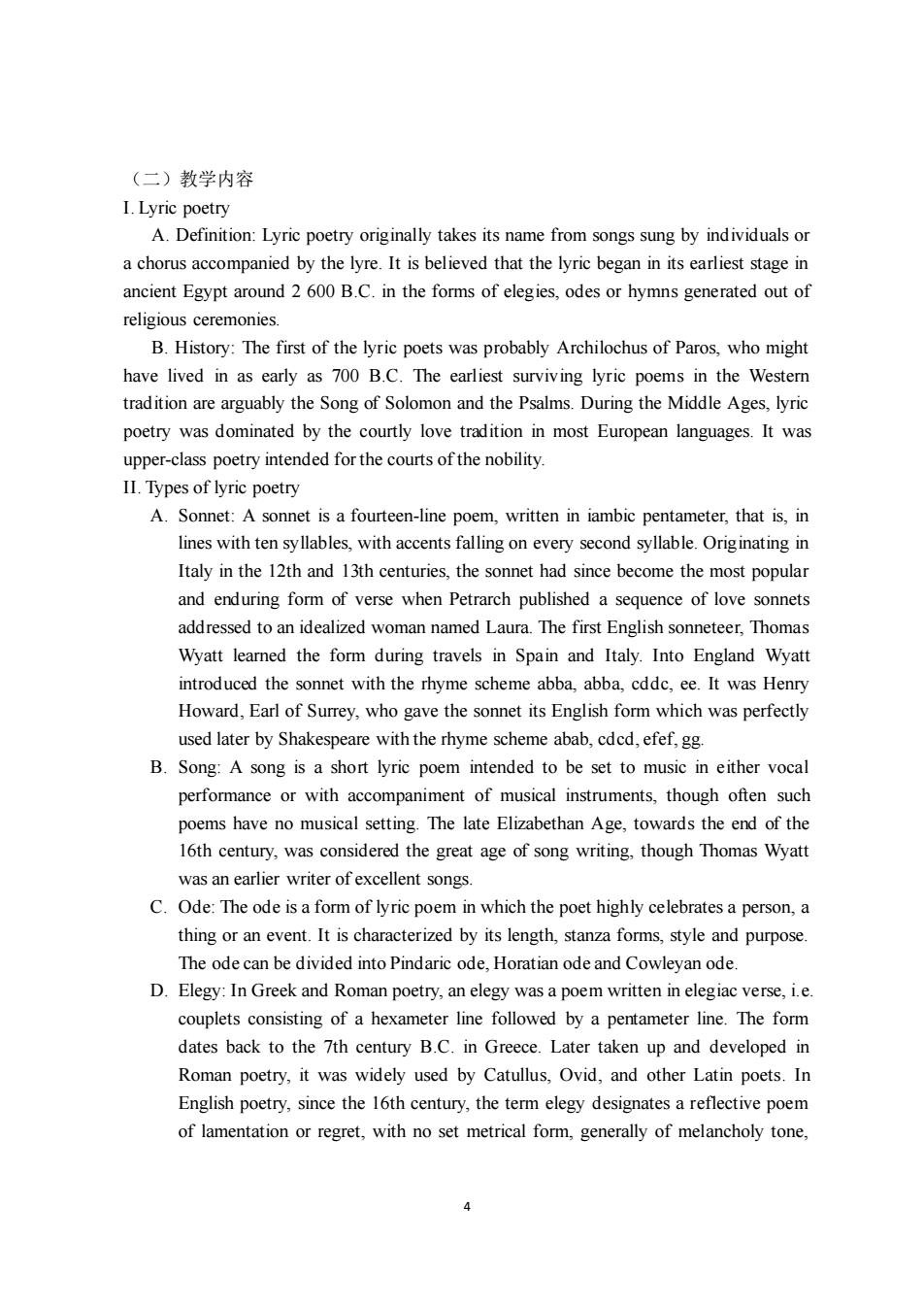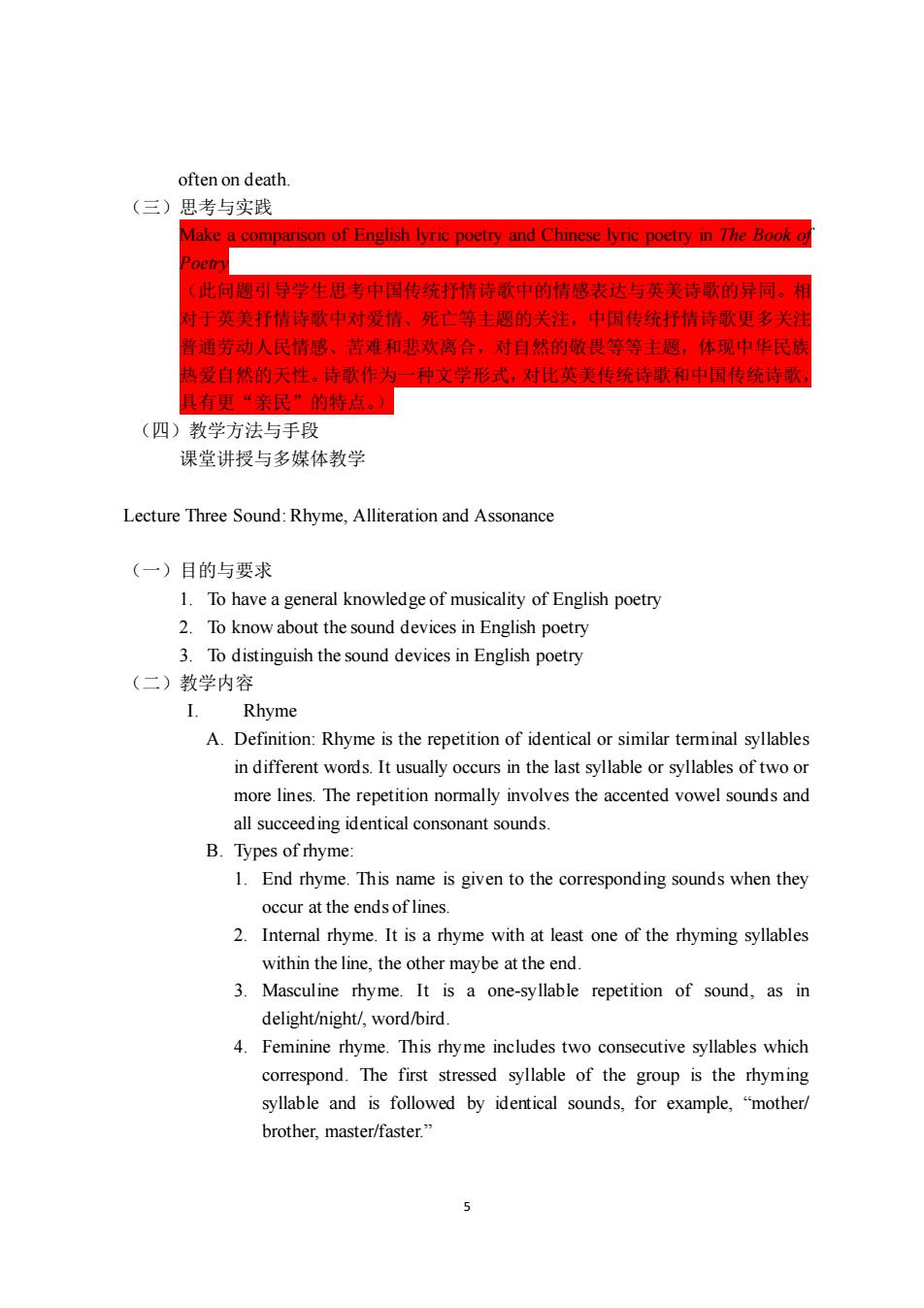
《英美诗歌欣赏》课程教学大纲 The Course Syllabus of a Course of British and American Poetry 一、课程基本信息(Basic Course Information) 课程代码:16221501 Course code:16221501 课程名称:英美诗歌欣赏 Course name:a course of british and american poetry 课程类别:通识选修课 Course type:Liberal Course 学时:16 Periods:16 学分:1 Credits I 适用对象:全校各专业学生 Target students:Undergraduates of all majors 考核方式:考查 Assessment:Examination/Pape 先修课程:大学英语 Preparatory courses:Course English I-II 二、课程简介(Brief Course Introduction) 本课程为通识选修课,于每个学期开设,是提高全校学生人文素养的一门选修课程 本课程介绍英美诗歌的主要类型:叙事诗歌、抒情诗歌以及戏剧性诗歌。着重讲述抒 情诗歌的主要形式:十四行、颂歌体、歌谣体以及挽歌体;介绍英语诗歌的要素:音 律以及甲韵,遣词造句,多辞以及意象,象征以及寓言等知识,使学生能够比较系统 了解英美诗歌的特点,能够初步运用英美诗歌知识进行简单的赏析。 A Course of British and American Poetry is a liberal course for students of the all majors, aiming to provide the general knowledge of British and American poetry,deepen the understanding of English and American culture.It introduces the major types of English poetry:narrative poetry,lyric poetry and dramatic poetry,elaborates on lyric poetry, specifically introducing sonnet,ode,song and elegy,focuses on the poetic elements: musicality of the poetry (sound,rhythm and meter),image,figures of speech,voice,diction
1 《英美诗歌欣赏》课程教学大纲 The Course Syllabus of a Course of British and American Poetry 一、课程基本信息(Basic Course Information) 课程代码:16221501 Course code: 16221501 课程名称:英美诗歌欣赏 Course name: A Course of British and American Poetry 课程类别:通识选修课 Course type: Liberal Course 学时:16 Periods: 16 学分:1 Credits: 1 适用对象:全校各专业学生 Target students: Undergraduates of all majors 考核方式:考查 Assessment: Examination/Paper 先修课程:大学英语 I-II Preparatory courses: Course English I-II 二、课程简介(Brief Course Introduction) 本课程为通识选修课,于每个学期开设,是提高全校学生人文素养的一门选修课程。 本课程介绍英美诗歌的主要类型:叙事诗歌、抒情诗歌以及戏剧性诗歌。着重讲述抒 情诗歌的主要形式:十四行、颂歌体、歌谣体以及挽歌体;介绍英语诗歌的要素:音 律以及押韵,遣词造句,修辞以及意象,象征以及寓言等知识,使学生能够比较系统 了解英美诗歌的特点,能够初步运用英美诗歌知识进行简单的赏析。 A Course of British and American Poetry is a liberal course for students of the all majors, aiming to provide the general knowledge of British and American poetry, deepen the understanding of English and American culture. It introduces the major types of English poetry: narrative poetry, lyric poetry and dramatic poetry, elaborates on lyric poetry, specifically introducing sonnet, ode, song and elegy, focuses on the poetic elements: musicality of the poetry (sound, rhythm and meter), image, figures of speech, voice, diction

and syntax,symbol and allegory.Thus the students could systematically know about the features of English poetry,basically enabling them to appreciate an English poem. 三、课程性质与教学目的 本课程旨在通过一学期的阅读、讲授及讨论,使学生对英美诗歌的类型、要素和主题 有总体的了解,通晓英美诗歌的名篇和名家,并适当和中国诗歌作比较,并在掌握英 美诗歌常识的基础上,进一步提高文化修养,理解中西诗歌的相异,加深对英语语言 的文化内涵的认识,进一步深化对英美文化的洞察力。在进一步了解爽美诗歌之后 通过在形式体排、思相内容上过比以迎,加室中面传经诗的硬醒,了解中华民 莱厚且源远流长的文化传统,并探讨现今中国诗歌面临的问题,进而增强对现代中国 文化的认识,建立正确的世界观、人生观和价值观。 四、教学内容与要求 Lecture One Narrative Poetry:Epic,Ballad and Romance Dramatic Poetry (一)目的与要求 1.To know about the types of narrative poetry 2.To know about the features of dramatic poetry 3.To understand the functions of narrative poetry and dramatic poetry (二)教学内容 Narrative poetry A.Definition:narrative poem tells a story.It gives a verbal representation of a sequence of connected events and propels characters through a plot. It is always told by a narrator.Ideally,a narrative poem should balance the story with poetry and not be merely a story in the form of a poem with a loose thread of narrative to tie it together. B.Types of narrative poetry 1.Epic:The epic is a broadly defined genre of poetry,which recounts in a continuous narrative the life and action of a heroic or mythological person or group of persons.Some epics chronicle the origins of a civilization and embody its central beliefs and values. 2.Ballad:Far less ambitious than epic,a ballad is perhaps the most popular form of narrative poetry.It is a narrative poem or folk song which tells a story in simple colloquial language,usually in four-line stanzas with the second and fourth lines rhymed 3.Romance:Romance is primarily medieval fiction in verse or prose 2
2 and syntax, symbol and allegory. Thus the students could systematically know about the features of English poetry, basically enabling them to appreciate an English poem. 三、课程性质与教学目的 本课程旨在通过一学期的阅读、讲授及讨论,使学生对英美诗歌的类型、要素和主题 有总体的了解,通晓英美诗歌的名篇和名家,并适当和中国诗歌作比较,并在掌握英 美诗歌常识的基础上,进一步提高文化修养,理解中西诗歌的相异,加深对英语语言 的文化内涵的认识,进一步深化对英美文化的洞察力。在进一步了解英美诗歌之后, 通过在形式、体裁、思想内容上对比认识,加深中国传统诗歌的理解,了解中华民族 深厚且源远流长的文化传统,并探讨现今中国诗歌面临的问题,进而增强对现代中国 文化的认识,建立正确的世界观、人生观和价值观。 四、教学内容与要求 Lecture One Narrative Poetry: Epic, Ballad and Romance & Dramatic Poetry (一)目的与要求 1. To know about the types of narrative poetry 2. To know about the features of dramatic poetry 3. To understand the functions of narrative poetry and dramatic poetry (二)教学内容 I. Narrative poetry A. Definition: narrative poem tells a story. It gives a verbal representation of a sequence of connected events and propels characters through a plot. It is always told by a narrator. Ideally, a narrative poem should balance the story with poetry and not be merely a story in the form of a poem with a loose thread of narrative to tie it together. B. Types of narrative poetry 1. Epic: The epic is a broadly defined genre of poetry, which recounts in a continuous narrative the life and action of a heroic or mythological person or group of persons. Some epics chronicle the origins of a civilization and embody its central beliefs and values. 2. Ballad: Far less ambitious than epic, a ballad is perhaps the most popular form of narrative poetry. It is a narrative poem or folk song which tells a story in simple colloquial language, usually in four-line stanzas with the second and fourth lines rhymed. 3. Romance: Romance is primarily medieval fiction in verse or prose

dealing with adventures of chivalry and love.It originally meant a work written in the French language.The three centuries after the Norman Conquest saw the large scale of the introduction of French culture and literature,and through French literature the introduction of Italian literature. Dramatic poetry A.Definition:The term "dramatic poetry"describes any verse written for the stage.It is any poetry that uses the discourse of the characters involved to tell a story or portray a situation.It presents the voice of an imaginary character (or characters)speaking directly,without any additional narration by the author. B.Features:As it is employed in plays,dramatic poetry functions against a background of stage directions and settings and is spoken by actors.It is a little bit hard for the reader to read dramatic poetry.He must actively engage in it by"seeing"the unportrayed scene,providing the speaker's gestures,and giving answer to the unportrayed actions of the character being spoken to.As the reader so actively engages in the action,he instinctively comprehends the character through identification,thus the principal purpose of dramatic poetry is achieved (三)思考与实践 Make a comparison between the English narrative poetry and Chinese poetry (此问引导学生对比中西诗歌源头产生的异同,认识中国传统叙事诗数的 生表源于人民劳作生活的经验,非王侯将相的丰功伟绩,“勤劳”是中华民 天然的民族精神 应该练承和发扬。 (四)教学方法与手段 课堂讲授与多媒体教学 Lecture Two Lyric Poetry (一)目的与要求 1.To know about the definition of English lyric poetry 2.To know about the types of English lyric poetry 3.To distinguish between the major types of lyric poetry
3 dealing with adventures of chivalry and love. It originally meant a work written in the French language. The three centuries after the Norman Conquest saw the large scale of the introduction of French culture and literature, and through French literature the introduction of Italian literature. II. Dramatic poetry A. Definition: The term “dramatic poetry” describes any verse written for the stage. It is any poetry that uses the discourse of the characters involved to tell a story or portray a situation. It presents the voice of an imaginary character (or characters) speaking directly, without any additional narration by the author. B. Features: As it is employed in plays, dramatic poetry functions against a background of stage directions and settings and is spoken by actors. It is a little bit hard for the reader to read dramatic poetry. He must actively engage in it by “seeing” the unportrayed scene, providing the speaker’s gestures, and giving answer to the unportrayed actions of the character being spoken to. As the reader so actively engages in the action, he instinctively comprehends the character through identification, thus the principal purpose of dramatic poetry is achieved. (三)思考与实践 Make a comparison between the English narrative poetry and Chinese poetry (此问题引导学生对比中西诗歌源头产生的异同,认识中国传统叙事诗歌的产 生来源于人民劳作生活的经验,非王侯将相的丰功伟绩,“勤劳”是中华民族 天然的民族精神,应该继承和发扬。) (四)教学方法与手段 课堂讲授与多媒体教学 Lecture Two Lyric Poetry (一)目的与要求 1. To know about the definition of English lyric poetry 2. To know about the types of English lyric poetry 3. To distinguish between the major types of lyric poetry

(二)教学内容 I.Lyric poetry A.Definition:Lyric poetry originally takes its name from songs sung by individuals or a chorus accompanied by the lyre.It is believed that the lyric began in its earliest stage in ancient Egypt around 2 600 B.C.in the forms of elegies,odes or hymns generated out of religious ceremonies. B.History:The first of the lyric poets was probably Archilochus of Paros,who might have lived in as early as 700 B.C.The earliest surviving lyric poems in the Western tradition are arguably the Song of Solomon and the Psalms.During the Middle Ages,lyric poetry was dominated by the courtly love tradition in most European languages.It was upper-class poetry intended for the courts ofthe nobility. II.Types of lyric poetry A.Sonnet:A sonnet is a fourteen-line poem,written in iambic pentameter,that is,in lines with ten syllables,with accents falling on every second syllable.Originating in Italy in the 12th and 13th centuries,the sonnet had since become the most popular and enduring form of verse when Petrarch published a sequence of love sonnets addressed to an idealized woman named Laura.The first English sonneteer.Thomas Wyatt learned the form during travels in Spain and Italy.Into England Wyatt introduced the sonnet with the rhyme scheme abba,abba,cddc,ee.It was Henry Howard,Earl of Surrey,who gave the sonnet its English form which was perfectly used later by Shakespeare with the rhyme scheme abab,cded,efef,gg. B.Song:A song is a short lyric poem intended to be set to music in either vocal performance or with accompaniment of musical instruments,though often such poems have no musical setting.The late Elizabethan Age,towards the end of the 16th century,was considered the great age of song writing.though Thomas Wyatt was an earlier writer of excellent songs C.Ode:The ode is a form of lyric poem in which the poet highly celebrates a person,a thing or an event.It is characterized by its length,stanza forms,style and purpose. The ode can be divided into Pindaric ode.Horatian ode and Cowleyan ode. D.Elegy:In Greek and Roman poetry,an elegy was a poem written in elegiac verse,i.e. couplets consisting of a hexameter line followed by a pentameter line.The form dates back to the 7th century B.C.in Greece.Later taken up and developed in Roman poetry,it was widely used by Catullus,Ovid,and other Latin poets.In English poetry.since the 16th century,the term elegy designates a reflective poem of lamentation or regret,with no set metrical form,generally of melancholy tone, 4
4 (二)教学内容 I. Lyric poetry A. Definition: Lyric poetry originally takes its name from songs sung by individuals or a chorus accompanied by the lyre. It is believed that the lyric began in its earliest stage in ancient Egypt around 2 600 B.C. in the forms of elegies, odes or hymns generated out of religious ceremonies. B. History: The first of the lyric poets was probably Archilochus of Paros, who might have lived in as early as 700 B.C. The earliest surviving lyric poems in the Western tradition are arguably the Song of Solomon and the Psalms. During the Middle Ages, lyric poetry was dominated by the courtly love tradition in most European languages. It was upper-class poetry intended for the courts of the nobility. II. Types of lyric poetry A. Sonnet: A sonnet is a fourteen-line poem, written in iambic pentameter, that is, in lines with ten syllables, with accents falling on every second syllable. Originating in Italy in the 12th and 13th centuries, the sonnet had since become the most popular and enduring form of verse when Petrarch published a sequence of love sonnets addressed to an idealized woman named Laura. The first English sonneteer, Thomas Wyatt learned the form during travels in Spain and Italy. Into England Wyatt introduced the sonnet with the rhyme scheme abba, abba, cddc, ee. It was Henry Howard, Earl of Surrey, who gave the sonnet its English form which was perfectly used later by Shakespeare with the rhyme scheme abab, cdcd, efef, gg. B. Song: A song is a short lyric poem intended to be set to music in either vocal performance or with accompaniment of musical instruments, though often such poems have no musical setting. The late Elizabethan Age, towards the end of the 16th century, was considered the great age of song writing, though Thomas Wyatt was an earlier writer of excellent songs. C. Ode: The ode is a form of lyric poem in which the poet highly celebrates a person, a thing or an event. It is characterized by its length, stanza forms, style and purpose. The ode can be divided into Pindaric ode, Horatian ode and Cowleyan ode. D. Elegy: In Greek and Roman poetry, an elegy was a poem written in elegiac verse, i.e. couplets consisting of a hexameter line followed by a pentameter line. The form dates back to the 7th century B.C. in Greece. Later taken up and developed in Roman poetry, it was widely used by Catullus, Ovid, and other Latin poets. In English poetry, since the 16th century, the term elegy designates a reflective poem of lamentation or regret, with no set metrical form, generally of melancholy tone

often on death. (三)思考与实践 Make a comparson of English lyric poetry and Chinese lyric poetry in The Book of (此问题引导学生思专中国传统抒情诗歌中的情感表达与英美诗歌的异同。有 付于英美抒情诗歌中对爱情、死亡等主恩的关注,中国传统抒情诗歌更多关 普通劳动人民情感、苦难和悲欢离合,对自然的放畏等等生题,体现中华民。 热爱自然的天性。诗歌作 种文学形式,对比英关传统诗歌和中国传统诗歌 具有更“亲民”的特点。 (四)教学方法与手段 课堂讲授与多媒体教学 Lecture Three Sound:Rhyme,Alliteration and Assonance (一)目的与要求 1.To have a general knowledge of musicality of English poetry 2.To know about the sound devices in English poetry 3.To distinguish the sound devices in English poetry (二)教学内容 Rhyme A.Definition:Rhyme is the repetition of identical or similar terminal syllables in different words.It usually occurs in the last syllable or syllables of two or more lines.The repetition normally involves the accented vowel sounds and all succeed ing identical consonant sounds. B.Types of rhyme 1.End rhyme.This name is given to the corresponding sounds when they occur at the endsof lines 2.Internal rhyme.It is a rhyme with at least one of the rhyming syllables within the line,the other maybe at the end. 3.Masculine rhyme.It is a one-syllable repetition of sound,as in delight/night/,word/bird. 4.Feminine rhyme.This rhyme includes two consecutive syllables which correspond.The first stressed syllable of the group is the rhyming syllable and is followed by identical sounds,for example,"mother/ brother.master/faster
5 often on death. (三)思考与实践 Make a comparison of English lyric poetry and Chinese lyric poetry in The Book of Poetry (此问题引导学生思考中国传统抒情诗歌中的情感表达与英美诗歌的异同。相 对于英美抒情诗歌中对爱情、死亡等主题的关注,中国传统抒情诗歌更多关注 普通劳动人民情感、苦难和悲欢离合,对自然的敬畏等等主题,体现中华民族 热爱自然的天性。诗歌作为一种文学形式,对比英美传统诗歌和中国传统诗歌, 具有更“亲民”的特点。) (四)教学方法与手段 课堂讲授与多媒体教学 Lecture Three Sound: Rhyme, Alliteration and Assonance (一)目的与要求 1. To have a general knowledge of musicality of English poetry 2. To know about the sound devices in English poetry 3. To distinguish the sound devices in English poetry (二)教学内容 I. Rhyme A. Definition: Rhyme is the repetition of identical or similar terminal syllables in different words. It usually occurs in the last syllable or syllables of two or more lines. The repetition normally involves the accented vowel sounds and all succeeding identical consonant sounds. B. Types of rhyme: 1. End rhyme. This name is given to the corresponding sounds when they occur at the ends of lines. 2. Internal rhyme. It is a rhyme with at least one of the rhyming syllables within the line, the other maybe at the end. 3. Masculine rhyme. It is a one-syllable repetition of sound, as in delight/night/, word/bird. 4. Feminine rhyme. This rhyme includes two consecutive syllables which correspond. The first stressed syllable of the group is the rhyming syllable and is followed by identical sounds, for example, “mother/ brother, master/faster